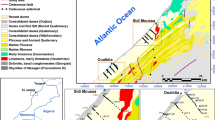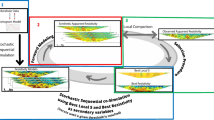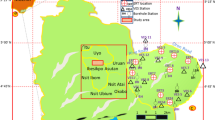Abstract
 Electrical Resistivity Tomography (ERT) has become a standard application for evaluation of structural and hydraulic properties of landslides. The technical improvement during the last few years made the method of ERT also attractive for long-term monitoring in term of regularly repeated measurements as newly developed 4-D inversion routines can assure the comparability of different ERT measurements. The interpretation of the achieved data is typically carried out qualitatively on a visual basis. In the framework of the LAMOND project (Long-Term Landslide Monitoring for Understanding of Underlying Dynamic Processes as Basis for an End-User Focused Early Warning) the abilities of numerical optimization and finite element modeling are conducted to close the gap between ERT observations and a dynamic, hydrological process model. So far, only one site could be examined and a workflow for numerical optimization of Archies law has been developed. These results will be the basis for a finite element process model which will deliver basic insights and help in decision-making for early warning systems.
Electrical Resistivity Tomography (ERT) has become a standard application for evaluation of structural and hydraulic properties of landslides. The technical improvement during the last few years made the method of ERT also attractive for long-term monitoring in term of regularly repeated measurements as newly developed 4-D inversion routines can assure the comparability of different ERT measurements. The interpretation of the achieved data is typically carried out qualitatively on a visual basis. In the framework of the LAMOND project (Long-Term Landslide Monitoring for Understanding of Underlying Dynamic Processes as Basis for an End-User Focused Early Warning) the abilities of numerical optimization and finite element modeling are conducted to close the gap between ERT observations and a dynamic, hydrological process model. So far, only one site could be examined and a workflow for numerical optimization of Archies law has been developed. These results will be the basis for a finite element process model which will deliver basic insights and help in decision-making for early warning systems.
Access provided by CONRICYT-eBooks. Download conference paper PDF
Similar content being viewed by others
Keywords
- Early warning
- Parameter optimization
- Finite element
- Hydraulic properties
- Water-driven landslides
- Geophysics
- Electrical resistivity tomography
- ERT
- Modeling
Introduction
Landslides are one of the major natural threats to human lives, settlements and infrastructure, causing enormous human suffering and property losses. The best way to restrain such high losses on property and lives is through effective land-use planning, based on a good knowledge of the landslide susceptibility, hazard and risk within specific areas as a part of mitigation. However, due to several natural, historical or political reasons, this ideal approach cannot be implemented in many places. For instance, many human settlements and infrastructure lines already exist in landslide-prone areas or on dormant landslides decades, before the establishment of detailed hazard zone maps. As a result, in most cases it is not possible to resettle people living in risky areas.
In order to increase safety standards in such areas, monitoring and early warning systems are necessary and have to be complemented with the preparation and updating of emergency plans, awareness raising campaigns, risk education activities and construction of protection works. However, in Austria the concept of early warning is far from being established. Significant funds are spent every year for remediation measures, but hardly any funding is allocated on a local level for installing and maintaining early warning systems.
The evaluation of actual hazards and the warning of people before a catastrophic event require a good knowledge about structure, dynamics, triggers, history and possible magnitude of such high-risk landslides. This knowledge can only be obtained via interpretation of complex data sets coming from investigations by different complementary techniques, acquired within long-time continuous monitoring experiments. The objectives of the presented project LAMOND are clustered in three groups, that are: (a) Improving the observation, (b) understanding and prediction of subsurface processes leading to the triggering of landslides, as well as (c) investigating the handling of its social consequences by developing new processes and methods for stakeholder involvement in the design of a warning system including issues related to stakeholders risk perceptions, warning communication and decision making, resulting in recommendations for end-user focused EW systems. After a short general introduction of the LAMOND project, this paper will focus on the activities related to the improvement of understanding and prediction of subsurface processes. Within this task, Electrical Resistivity Tomography (ERT) monitoring data is used to assess the hydraulic properties of the underground using Finite Element Modeling in combination with an optimization routine. Since a change of the water saturation influences the electrical resistivity, seepage of infiltrating rain water is clearly visible in the ERT section during and after rainfall events. Such events are used for calibration of the numerical models.
The LAMOND Project
Since 2007, the Geological Survey of Austria has run a multi-parametric European landslide monitoring network, which is mainly based on Electrical Resistivity Tomography (ERT) monitoring in combination with other geotechnical parameters (displacement, precipitation, soil moisture, et cetera). The LAMOND project is the continuation of these landslide monitoring activities. Hydrological interpretation of the collected ERT data is typically carried out qualitatively on a visual basis. The project LAMOND aims firstly at improving the observation, understanding and prediction of subsurface processes triggering landslides, based on an innovative, multi-parameter monitoring technology and the long-term observation of triggering events in different geological settings. The second part, the focus of this paper, is numerical modeling in combination with parameter estimation to build a basis for an enhanced hydrological interpretation of the ERT results. Furthermore, the project focuses on the handling of the social consequences of warning by developing new processes and methods for stakeholder involvement in the design of a warning system, ending up with recommendations for an end-user focused early warning system (Fig. 1).
Monitoring Network
The LAMOND Monitoring Network is the continuation of the Landslide monitoring activities from the last 8 years (EC FP-7 project SAFELAND, FWF project TEMPEL). Within the LAMOND project additional Monitoring sites, namely Navis ín Tyrol and Gresten in Upper Austria, had been deployed. Hence, the network consists of 5 sites where Geoelectrical monitoring and additional geotechnical methods (inclinometers, photo monitoring, soil moisture) are applied. Three of these sites are situated in Austria, one in France and one in Italy. The Italian site, Bagnaschino, is the oldest still-active site, for which ERT monitoring data are available since 2011. During and after heavy rainfall events the infiltration of rainwater is clearly visible in the ERT monitoring profiles.
Electrical Resistivity Tomography Monitoring
Within the last several years, the geoelectrical method has become a routine geophysical method to investigate subsurface geometry and structural pattern of landslides (e.g. Perrone et al. 2006). Electrical Resistivity Tomography delivers a cross-sectional view of the resistivity distribution along a vertical profile. Furthermore, in the recent past technological improvements made the geoelectrical method also attractive for the application in the field of long-term monitoring of landslides to evaluate changes of the subsurface resistivity in time. These variations are predominantly linked with changes of the hydrological regime of the subsurface, thus the geoelectrical monitoring data can provide additional information about water infiltration, distinct water flow paths and groundwater table changes (e.g. Chambers et al. 2011; Supper et al. 2014; Gance et al. 2016).
The overall geoelectrical data acquisition (common measurements and monitoring application) in this study was carried out with the Geomon 4D system, an autonomous resistivity instrument developed by the Geological Survey of Austria (for details see Supper et al. 2014).
ERT monitoring data is processed using a newly developed 4D-inversion approach (Kim et al. 2013). This software allows creating difference images of inverted resistivity monitoring data by inverting the dataset in 4D. Furthermore, in the context of a close cooperation of the GBA and the Korea Institute of Geoscience and Mineral Resources (KIGAM) within different research projects (e.g. TEMPEL project (TRP 175-N21)—funded by the Austrian Science Fund), several additional software improvements in the field of processing of geoelectrical monitoring data were achieved (e.g. Kim et al. 2014). The geoelectrical results presented in this study are partly based on these developments.
Enhanced ERT Monitoring Data Interpretation
A new, innovative approach for ERT monitoring data interpretation based on numerical optimization of Archies Law is being developed in the framework of the LAMOND project. Archies Law is an empirical formula for bulk electrical resistivity of partially saturated porous media (Eq. 1). The optimization routine is based on the SNOPT algorithm (Sparse Nonlinear Optimization—Gill et al. 2005), implemented in the COMSOL Multiphysics numerical modelling environment.
where ρ represents the bulk electrical resistivity of the partly saturated medium, ρ W is the resistivity of the brine. Φ and S are porosity and water saturation, the exponents m and n are the cementation and saturation exponents. Finally, a represents the Tortuosity factor. For short-term examinations like rainfall events all parameters but the water saturation can be considered as constant in time, so a change of electrical resistivity in time can only be explained by a change in water saturation. Long-term behavior (e.g. seasonal) is heavily influenced by temperature change, even the porosity or tortuosity may change with time due to changes of the stress regime or creeping of the landslide mass. In this paper, we focus on the short-term behavior.
If we express the change of the electrical resistivity as resistivity quotient, it equals the inverse quotient of water saturation to the power of the saturation exponent:
where the indices (1, 2) represent the resistivity or water saturation at different times. Hence, the resistivity quotient can be expressed as a simple function of two different states of saturation. Using this expression as a constraint, two (or more) time steps of the 4D ERT inversion result can be used for the optimization routine simultaneously. Darcys Law (Eq. 1) is applied as the objective function for the optimization routine, whereas the 4D inversion results from different time steps—prior to and after an infiltration event—are used as reference. The resistivity quotient (Eq. 2) is set as the constraint while the porosity, water saturation, tortuosity as well as the two exponents are being optimized by the optimization routine. Figure 2 shows a sketch of the optimization workflow.
At the first stage, one monitoring site had to be chosen for the development of a viable optimization workflow, at a later stage of the project the developed workflow will be applied to other monitoring sites. The Bagnaschino site was chosen as our initial test site for multiple reasons. First of all, there is the longest continuous time series of ERT measures available at the Bagnaschino site and the site is very active, multiple sliding events have been registered by the installed inclinometers. Furthermore, the aspect of early warning is the predominant aim at this site, and no remediation measures were applied there so far. Hence, the hydraulic behavior of the Bagnaschino site is not influenced by artificial effects.
Example Site Bagnaschino
The Bagnaschino site represents a landslide/earthflow reactivated within an old landslide mass. The old landslide is situated on the E slopes of the Val Casotto about 4 km SE of Torre Mondovì (NW Italy) and developed in tectonically dense jointed calcareous-mica schist and diamictic colluvium superimposed on altered amphibolite and prasinite. Evident indications of deep-seated gravitational deformation (crowns and scarps, zone of accumulation of large paleoslides, etc.) suggest that the current slopes are in a condition of limit-equilibrium and are predisposed to slow instability, triggered most probably by rain and/or snow melting and river erosion at the foot. The recent landslide was activated during a rainfall event in 1994. It covers an estimated area of 150,000 m2 and comprises displaced material of 1.2 million m3 (only the flow part). It endangers a regional highway and potential formation of a dam. A DMS inclinometer monitoring column 60 m long was installed in October 2008 and it allowed investigation of several displacement events, based at a depth of 8 m b.g.l. A perched ground water level was registered at a depth of about 6.5 m b.g.l., which is probably the main triggering factor of the active sliding zone. The displacement has a distinct relation to rainfall events or snow melting. Except that rather shallow movement, deep creep of the old landslide has been recognized about 30–44 m b.g.l. Total displacement recorded by DMS inclinometer during the events between 2008 and 2010 was 600 mm. Subsequently, the GEOMON technique was installed there in 2010. The main aim of the monitoring is early warning for Civil Protection.
Results (Preliminary)
As the LAMOND project is still going on, the presented results are preliminary and show the status at the moment of paper submission. So far, an optimization workflow using Archies law has been developed and tested for the Bagnaschino test site. Figure 3 shows a compilation of the optimizations input data and the results of the first optimization run.
Conclusions
The implementation of parameter estimation and finite element modelling makes the interpretation of ERT data quantifiable in terms of water saturation or soil moisture content, respectively. This is a crucial step towards closing the gap between field measurements (ERT Monitoring) and a hydrological process model which can be the basis for definition of Early Warning Levels on rainfall-induced landslides.
Outlook
The developed workflow has to be tested and validated on more rainfall events and also on other sites of the LAMOND network. Furthermore, as Archies law is limited to non-clayish conditions, the possibilities of applying an adapted approach to the Waxman-Smith equation, which can be understood as an extension of Archies Law for clayish conditions, will be examined.
References
Chambers JE, Wilkinson PB, Kuras O, Ford JR, Gunn DA, Meldrum PI, Pennington CVL, Weller AL, Hobbs PRN, Ogilvy RD (2011) Three-dimensional geophysical anatomy of an active landslide in Lias Group mudrocks, Cleveland Basin, UK. Geomorphology 125:472–484
Gance J, Malet JP, Supper R, Sailhac P, Ottowitz D, Jochum B (2016) Permanent electrical resistivity measurements for monitoring water circulation in clayey landslides. J Appl Geophys 126:98–115
Gill PE, Murray W, Saunders MA (2005) SNOPT: an SQP algorithm for large-scale constrained optimization. SIAM Rev 47(1):99–131. Society for Industrial and Applied Mathematics
Kim JH, Supper R, Tsourlos P, Yi MJ (2013) Four-dimensional inversion of resistivity monitoring data through Lp norm minimizations. Geophys J Int 195(3):1640–1656
Kim JH, Yi MJ, Supper R, Ottowitz D (2014) Simultaneous inversion of resistivity structure and electrode locations in ERT. Near Surf Geosci, 18 Sept 2014. Athens
Perrone A, Zeni G, Piscitelli S, Pepe A, Loperte A, Lapenna V, Lanari R (2006) Joint analysis of SAR interferometry and electrical resistivity tomography surveys for investigating ground deformation: the case-study of Satriano di Lucania (Potenza, Italy). Eng Geol 88:260–273
Supper R, Ottowitz D, Jochum B, Kim JH, Römer A, Baron I, Pfeiler S, Lovisolo M, Gruber S, Vecchiotti F (2014) Geoelectrical monitoring: an innovative method to supplement landslide surveillance and early warning. Near Surf Geophys 12(1):133–150
Acknowledgements
The LAMOND project is funded by the Austrian Academy of Sciences/Earth System Science program (ESS). Most landslide-related activities of the Geological survey of Austria are also supported by the Austrian Torrent and Avalanche Control (WLV).
Author information
Authors and Affiliations
Corresponding author
Editor information
Editors and Affiliations
Rights and permissions
Copyright information
© 2017 Springer International Publishing AG
About this paper
Cite this paper
Hoyer, S., Ottowitz, D., Jochum, B., Pfeiler, S., Supper, R., Kim, JH. (2017). Numerical Modelling of Hydrological Parameters for an Enhanced Interpretation of ERT Monitoring Data. In: Mikos, M., Tiwari, B., Yin, Y., Sassa, K. (eds) Advancing Culture of Living with Landslides. WLF 2017. Springer, Cham. https://doi.org/10.1007/978-3-319-53498-5_63
Download citation
DOI: https://doi.org/10.1007/978-3-319-53498-5_63
Published:
Publisher Name: Springer, Cham
Print ISBN: 978-3-319-53497-8
Online ISBN: 978-3-319-53498-5
eBook Packages: Earth and Environmental ScienceEarth and Environmental Science (R0)







